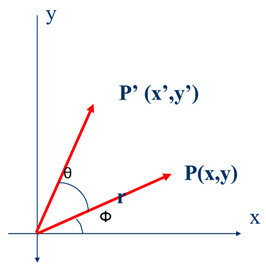 1. Starting with Polar Coordinates
1. Starting with Polar Coordinates
-
Consider a point P with Cartesian coordinates .
-
We can represent the same point P using polar coordinates , where:
ris the distance from the origin to the point (the radius).α(alpha) is the angle between the positive x-axis and the line connecting the origin to the point.
-
The relationship between Cartesian and polar coordinates is:
2. Rotating the Point
- Now, let’s rotate the point P by an angle counterclockwise around the origin to a new position P’ with coordinates .
- In polar coordinates, the new point P’ will have the same radius
rbut a new angleα + θ. - Therefore, the Cartesian coordinates of the rotated point P’ are:
3. Applying Trigonometric Identities
-
We can use the angle addition formulas for cosine and sine to expand the expressions for
x'andy': -
Substituting these into the equations for
x'andy':
4. Substituting Back to Cartesian Coordinates
- Recall that and .
- Substitute these back into the equations for
x'andy': - This simplifies to:
5. Matrix Form (Homogeneous Coordinates)
-
We can express these equations in matrix form using homogeneous coordinates: